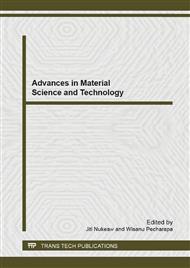p.79
p.84
p.89
p.94
p.99
p.104
p.109
p.114
p.119
Investigation of a Biodegradable Polymer Electrolytes Based on Carboxy Methylcellulose and its Potential Application in Solid-State Batteries
Abstract:
The increasing interest in green energy storage materials for electrochemical devices with the development of polymer as electrolytes candidate has attracted great attention recently. It can offer a number of high-value opportunities, provided that lower costs can be obtained besides environmental friendly. Due to this attention, the development of biodegradable polymer electrolytes (BPEs) has been accomplished in this work by incorporating various composition of dodecyltrimethyl ammonium bromide (DTAB) with carboxy methylcellulose (CMC) via solution casting method. The highest ionic conductivity of the BPEs obtained at room temperature is 7.72 x 10-4 S cm-1. The solid-state battery were fabricated with the configuration of Zn + ZnSO4.7H2O | BPEs | MnO2 for the highest conductivity. The open-circuit voltage (OCV) of the fabricated battery with the best performance is 1.33 V at ambient temperature. The performance of the battery at ambient and selected temperature is evaluated to ascertain the effective and viability of these BPEs in solid-state batteries.
Info:
Periodical:
Pages:
99-103
Citation:
Online since:
September 2013
Price:
Сopyright:
© 2013 Trans Tech Publications Ltd. All Rights Reserved
Share:
Citation:


